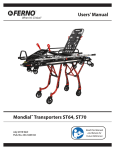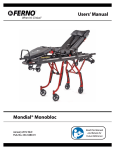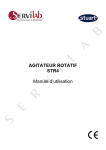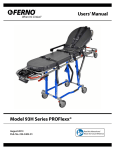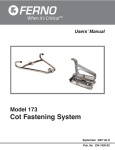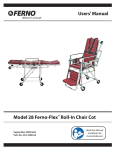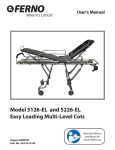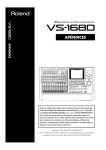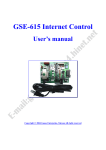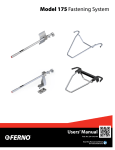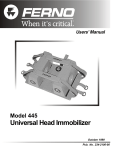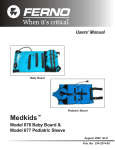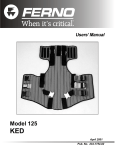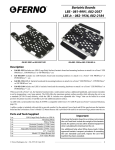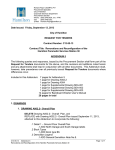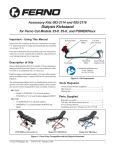Download 5 - USing The TranSPOrTer
Transcript
FERNO ® When It’s Critical ® Users’ Manual Mondial® Transporters ST64, ST70 August 2013 GLO Pub. No. 234-3449-05 Read this Manual and Retain for Future Reference Mondial® Transporters ST64, ST70 Ferno Technical Support Customer service and product support are important aspects of each Ferno product. Please have the product serial number available when calling, and include it in all written communications. For technical support questions: Telephone (Toll-free) 1.800.733.3766 ext. 1010 Telephone 1.937.382.1451 ext. 1010 [email protected] Ferno Customer Relations users’ manual To request additional free users’ manuals, contact Ferno Customer Relations, your Ferno distributor, or visit www.ferno.com. Serial Number For ordering assistance or general information: Canada and the U.S.A. Telephone (Toll-free) 1.877.733.0911 Telephone 1.937.382.1451 Fax (Toll-free) 1.888.388.1349 Fax1.937.382.1191 Internetwww.ferno.com All Other Locations For assistance or information, please contact your Ferno distributor. If you do not have a Ferno distributor, please contact Ferno Customer Relations: Ferno-Washington, Inc., 70 Weil Way Wilmington, Ohio 45177-9371, U.S.A. Telephone +1.937.382.1451 Fax+1.937.382.6569 Internetwww.ferno.com Serial Number _________________________ Location: Side Rail on Patient Left side Disclaimer This manual contains general instructions for the use, operation and care of this product. The instructions are not all-inclusive. Safe and proper use of this product is solely at the discretion of the user. Safety information is included as a service to the user. All other safety measures taken by the user should be within and under consideration of applicable regulations. It is recommended that training on the proper use of this product be provided before using this product in an actual situation. Retain this manual for future reference. Include it with the product in the event of transfer to new users. Additional free copies are available upon request from Customer Relations. Proprietary Notice The information disclosed in this manual is the property of FernoWashington, Inc., Wilmington, Ohio, USA. Ferno-Washington, Inc. reserves all patent rights, proprietary design rights, manufacturing rights, reproduction use rights, and sales use rights thereto, and to any article disclosed therein except to the extent those rights are expressly granted to others or where not applicable to vendor proprietary parts. Limited Warranty Statement The products sold by Ferno are covered by a limited warranty, which is printed on all Ferno invoices. The complete terms and conditions of the limited warranty, and the limitations of liability and disclaimers, are also available upon request by calling Ferno at 1.800.733.3766 or 1.937.382.1451. 2 © Ferno-Washington, Inc 234-3449-05 August 2013 Mondial® Transporters ST64, ST70 Table of Contents SectionPage SectionPage Ferno Technical Support__________________________2 Ferno Customer Relations_________________________2 1 - Safety Information______________________________4 1.1Warning___________________________________4 1.2Important__________________________________4 1.3Tip________________________________________4 1.4 Bloodborne Disease Notice____________________4 1.5 Safety and Instruction Labels__________________5 1.5 Transporter and Fastening System Compatibility__4 1.6 Symbol Glossary____________________________5 2 - Operator Skills and Training______________________6 2.1Skills______________________________________6 2.2Training___________________________________6 2.3 Height and Strength Considerations____________6 3 - About the Transporter___________________________7 3.1Description________________________________7 3.2Compliance________________________________7 3.3Components_______________________________8 3.4 General Specifications________________________9 3.5 Bed Positions_______________________________9 4 - Using the Features____________________________ 10 4.1 EZ Pull™ Leg Control Handles_________________10 4.2 Leg-Status Indicator________________________10 4.3 Stretcher Release Lever (Yellow)_______________10 4.4 Swivel-Lock Release Lever____________________11 4.5 Stretcher Slam Latches______________________12 4.6 Wheel Locks_______________________________12 4.7 Transport Wheels___________________________12 4.8 Intermediate Loading Wheels_________________13 4.9 EZ Load™ Automatic Leg Release (Loading-End Legs)_________________________13 4.10 EZ Load™ Automatic Leg Release (Control-End Legs, Optional)__________________13 4.11 Safety-Lock Device (Optional)_________________14 4.12 Leg Lock (Blue Lever, Optional)________________14 5 - Using the Transporter__________________________ 15 5.1 Before Placing the Transporter in Service________15 5.2 General Guidelines for Use___________________15 5.3 Attaching and Removing A Stretcher___________16 5.4 Changing Transporter Positions_______________17 5.5 Transferring the Patient______________________18 5.6 Rolling the Transporter______________________19 5.7 Loading the Transporter_____________________20 5.8 Unloading the Transporter___________________21 5.9 Carrying the Transporter_____________________22 5.10 One Operator, Empty Transporter______________22 5.11 Using Additional Help_______________________23 6 - Maintenance_________________________________ 24 6.1 Maintenance Schedule______________________24 6.2Tracker™ (Optional)__________________________24 6.3 Disinfecting the Transporter__________________25 6.4 Cleaning the Transporter_____________________25 6.5 Waxing the Transporter______________________25 6.6 Inspecting the Transporter___________________25 6.7 Lubricating the Transporter__________________26 7 - Parts, Service, and Accessories__________________ 27 7.1 Parts and Service___________________________27 7.2Accessories________________________________27 Training Record_________________________________ 28 Maintenance Record_____________________________ 28 © Ferno-Washington, Inc 234-3449-05 August 2013 3 Safety Information Mondial® Transporters ST64, ST70 1 - Safety Information 1.1Warning 1.2Important Warning notices indicate a potentially hazardous situation which, if not avoided, could result in injury or death. Important notices emphasize important usage or maintenance information. Failure to follow Important notices could result in damage to the product or property damage. Warning Important Untrained operators can cause injury or be injured. Permit only trained personnel to operate the transporter. Improper use of the transporter can cause injury. Use the transporter only for the purpose described in this manual. Releasing the swivel locks increases the possibility for the transporter to tip. Maintain control of the transporter at all times. 1.3Tip Tips provide recommendations for easier use of the product. Improper operation can cause injury. Operate the transporter only as described in this manual. An unattended patient can be injured. Stay with the patient at all times. An unrestrained patient can fall off the transporter and be injured. Use restraints to secure the patient on the transporter. An improperly secured stretcher can separate from the transporter and cause injury. Attach the stretcher securely and verify that the slam latches have locked. Rolling the transporter sideways can cause the transporter to tip and injure the patient or operators. Roll the transporter only with the head-end or foot-end first. An unlocked undercarriage can cause injury. Before removing the transporter from the ambulance, confirm that both sets of legs unfold completely and lock. Helpers can cause injury or be injured. Maintain control of the transporter, operate the controls, and direct all helpers. Improper maintenance can cause injury. Maintain the transporter only as described in this manual. Improper parts and service can cause injury. Use only Ferno parts and Ferno-approved service on the transporter. Modifying the transporter can cause injury and damage. Use the transporter only as designed by Ferno. Attaching improper items to the transporter can cause injury. Use only Ferno-approved items on the transporter. 4 1.4Bloodborne Disease Notice To reduce the risk of exposure to bloodborne diseases such as HIV-1 and hepatitis when using the transporter, follow the disinfecting and cleaning instructions in this manual. 1.5 Transporter and Fastening System Compatibility For the purpose of the following notice, the Mondial® ST64 and ST70 and all other Ferno transporters are included under the generic term “cot”. Combining different manufacturer’s products such as a Ferno cot with a non-Ferno fastening system can increase the user’s risk of injury and damage. Ferno-Washington, Inc. cots are designed for use only with Ferno-manufactured fastening systems. Use of this Ferno cot with a non-Ferno fastening system is misuse of the Ferno product. The user assumes responsibility for the outcome of known, intentional misuse. © Ferno-Washington, Inc 234-3449-05 August 2013 Mondial® Transporters ST64, ST70 Safety Information 1.5 Safety and Instruction Labels Safety and instruction labels place important information from the users’ manual on the transporter. Read and follow label instructions. Replace worn or damaged labels immediately. New labels are available from your Ferno distributor. Swivel Lock Release Lever (Loading-end control panel) Safety Information Label (Control panels) Stretcher Release Lever (Control-end spine) Low-Bed Leg Lock Lever (Control-end control panel, when equipped) Undercarriage Lock Status (Undercarriage lock mechanisms) 1.6 Symbol Glossary The symbols defined below are used on the transporter and in this users’ manual. Ferno uses symbols recognized by the International Standards Organization (ISO), American National Standards Institute (ANSI) and the emergency medical services industry. 2 General Warning of Potential Injury Do Not Lubricate Lubricate QR Code (Scan with Smartphone to access online material) Locked Read the Users’ Manual Unlocked © Ferno-Washington, Inc 234-3449-05 August 2013 Operation Requires Two Trained Operators Manufacturer Authorized Representative in the European Community Load Limit Transporter meets European Union Standards 5 Operator Skills and Training Mondial® Transporters ST64, ST70 2 - Operator Skills and Training 2.1Skills 2.2Training Operators using the transporter need: Operator trainees need to: ● a working knowledge of emergency patient-handling procedures. ● read and understand this manual and the manuals for the fastener and stretcher(s) used with the transporter. ● the ability to assist the patient. ● be trained on the use of the transporter, the fastener, and the stretcher(s) used with the transporter. ● practice with the transporter before using it with a patient. ● record their training information. A sample training record sheet is provided on page 28. Warning Untrained operators can cause injury or be injured. Permit only trained personnel to operate the transporter. 2.3Height and Strength Considerations When unloading the transporter, the foot-end operator must lift and hold the weight of the transporter, patient and equipment high enough for the wheels to remain off the ground until the undercarriage legs completely unfold and lock into place. Be aware that if the ambulance is parked on an uneven surface, the foot-end operator (and any helpers) may need to lift the transporter higher than normal to allow the legs to unfold completely and lock. Supporting this weight requires greater strength from short operators than from tall operators because short operators must raise their arms higher in relation to their shoulders. Note: Use additional help as needed to lift the weight of the transporter, patient and equipment (see Using Additional Help, page 23). 6 © Ferno-Washington, Inc 234-3449-05 August 2013 Mondial® Transporters ST64, ST70 About the Transporter 3 - About the Transporter 3.1Description The Models ST64 and ST70 Mondial® Series Transporters are emergency patient-handling devices designed to transport a patient in a ground-based ambulance. In this manual, the term “transporter” is used when features are identical for both models. The specific transporter name is used when features differ. The transporter is for professional use by a minimum of two trained operators. It is designed for roll-in loading to help reduce the risk of back injury to medical service personnel. The transporter is part of a three-component patient-handling system when matched with a compatible Ferno® stretcher and fastener (not included). Compatible stretchers and stretcher chairs ● Mondial® RS2, RS3, RS4 stretchers EFX1 stretcher chair ● EFX2, EFX3, EFX4 stretchers ● compatible ferno® fasteners ● Ferno FL1 ● Ferno® EFX-Lock (conversion required, kit available separately) ® transporter features ● ● ● ● ● ● ● ● ● ● ● ● ● ● ● ● ● ● Ergonomic control handles Choice of red, green, or silver legs Six bed positions and a folded position ST64: loading height of 64 cm ST70: loading height of 70 cm Stretcher slam-locks (two) EZ Pull™ control handles allow operators to operate the control handle first, before assuming the weight of the transporter during position changes. Control handles not required for raising the transporter Automatic loading-leg release (when loading transporter into an ambulance); control handles not required to unlock loading legs Intermediate loading wheels reduce the amount of lifting required when loading the transporter into, and unloading it from, an ambulance. Reversible stretcher mounting Four 150 mm transport wheels ○○ Control-end wheels with wheel locks (two) ○○ Loading-end wheels with swivel-locks (two) Extremely high-visibility reflective safety stripes Loading/Operator-end leg protectors (Optional) No control handles required for loading the transporter if equipped with EZ Load™ automatic leg release. (Optional) Leg lock locks both transporter legs in Bed Position 1 or Bed Position 3. (Optional) Safety Lock Device (Optional) Soft-ride transport wheels with antistatic feature © Ferno-Washington, Inc 234-3449-05 August 2013 Warning Improper use of the transporter can cause injury. Use the transporter only for the purpose described in this manual. 3.2Compliance medical device directive Ferno products meet the requirements of Medical Device Directive 93/42/ EEC as established by the European Union. certification The Mondial ST64 or ST70 transporter, when used with a Ferno® Mondial® or EFX stretcher plus a Ferno® FL1 or EFX-Lock fastener, meets European Harmonized Standards. ® Mondial® series products were independently tested by TÜV Rheinland, Germany, and certified compliant with EN 1865:1999, governing patient transport equipment, and EN 1789:2007, governing road ambulances. U.S.A. NOTICE The transporter is for use with ambulances that meet the requirements of the “Star of Life” certification via Federal Ambulance Specification KKK-A-1822. For information, contact: Federal Supply Services, Specifications Section Suite 8100 470 E. L’Enfant Plaza, SW Washington, DC 20407 7 About the Transporter Mondial® Transporters ST64, ST70 3.3Components Stretcher Release Lever (Yellow) Leg Status Indicator Swivel Lock Release Lever (Blue) Leg Control Lever (Red) Leg Status Indicator Leg Control Lever (Red) Leg Lock Lever (Optional) Loading-End Panel Control-End Panel Slam Latch (2) Leg Control Handle (Red) Swivel Lock Release Lever (Blue) Leg Lock Lever (Blue, Optional) Stretcher Release Lever (Yellow) Loading Wheel (2) Leg Control Handle (Red) Wheel Lock (2) Intermediate Loading Wheel (2) Control End Loading End Load Limit Inspect the transporter if the load limit has been exceeded (See Inspecting the Transporter, page 25). 8 © Ferno-Washington, Inc 234-3449-05 August 2013 Mondial® Transporters ST64, ST70 About the Transporter 3.4General Specifications 3.5Bed Positions Most general specifications are rounded to the nearest whole number. For more information, contact Ferno Customer Relations (page 2) or your Ferno distributor. Ferno reserves the right to change specifications without notice. MODEL ST70 AND MODEL ST64 150 mm/6 in. 44 mm/2 in. Sealed/greaseless Aluminum panels 1970 mm/77.5 in. 550 mm/22 in. 270 kg/600 lb 42.3 stone Loading Height Aluminum Bed Height Construction Transport Wheels Diameter Width Wheel Bearings Bed Surface Length Width Load Limit Load Limit (UK) Position 6 (Highest Rolling Position) MODEL ST70 Height Rolling Position 6 Bed Position 5 Bed Position 4 Bed Position 3 Bed Position 2 Bed Position 1 Folded Position Weight (ST70)2 1 1045 mm/41 in. 984 mm/39 in. 905 mm/36 in. 787 mm/31 in. 600 mm/24 in. 352 mm/14 in. 343 mm/14 in. 28 kg/62 lb MODEL ST64 Height Rolling Position 6 Bed Position 5 Bed Position 4 Bed Position 3 Bed Position 2 Bed Position 1 Folded (Ambulance) Position Weight (ST64)2 1 987 mm/39 in. 930 mm/37 in. 857 mm/34 in. 746 mm/29 in 560 mm/22 in 356 mm/14 in 346 mm/14 in 28 kg/62 lb Position 3 (Mid-Level Transfer/Rolling Position) AMBULANCE SPECIFICATION ST64 Floor/Tray Range3 ST70 Floor/Tray Range3 670-730 mm/27-29 in. 730-790 mm/29-31 in. Height measurements are the distance from the ground to the top of the stretcher seat panel with a stretcher on the transporter. 1 2 Weight is without stretcher or optional features. Ambulance floor/tray range is the recommended height range for proper loading and unloading. 3 Position 1 (Lowest Transfer Position) Folded Position © Ferno-Washington, Inc 234-3449-05 August 2013 9 Using the Features Mondial® Transporters ST64, ST70 4 - Using the Features 4.1EZ Pull™ Leg Control Handles ● ● ● Purpose: Unlocks the legs nearest the handle, allowing the transporter to be lowered Location: Each end of the transporter, accessible to the operator’s right hand (Figure 1) Use: The EZ Pull™-style handle allows the operators to operate the handle first, before lifting the transporter so they can and lift evenly. (For complete instructions, see Using the Transporter, pages 15-23) ○○ Lowering: Operators pull both control handles at the same time, then lift the transporter to take the weight off the locking mechanism. The leg-status indicator changes to red when the undercarriage is unlocked and changes to green when the lock is engaged (See Leg-Status Indicator, below). ○○ Raising: Do not use the leg control handles. The operators simultaneously lift the transporter main frame until the transporter locks at the desired height. ○○ Loading: The Control-end Operator uses the control-end handle when loading the transporter into an ambulance, unless the transporter is equipped with the control-end EZ Load™ automatic legrelease option. See EZ Load™ Automatic Leg Release (Control-end Legs, Optional), page 13. Figure 1 - Leg Control Handle Leg-Status Indicator The leg-status indicator indicates the state of the undercarriage leg lock: GREEN = Locked/Safe RED = Unlocked/Ready to Lower or Load 4.2Leg-Status Indicator ● Purpose: Indicates the status of the leg lock. ● Location: Control panel at each end of the transporter ● Use (Figure 2): The indicator changes automatically when the leg control handle at the same end of the transporter is used. ○○ Green: the legs are locked. ○○ Red: the legs are unlocked (the leg-control handle has been pulled) and the transporter may be lowered or loaded into an ambulance. ○○ Always maintain your grasp on the transporter until you verify that both legs have locked at the new position. Green = Locked Red = Unlocked Figure 2 - Leg-Status Indicator 4.3 Stretcher Release Lever (Yellow) ● Purpose: Unlocks the stretcher for removal ● Location: Transporter control end (Figure 3). ● Use: 1. Control Operator: Push and hold the stretcher release lever to disengage the transporter slam locks. 2. Both Operators: Roll the stretcher slightly toward the loading end of the transporter to move the stretcher strike pins away from the slam latch locks. 3. Control Operator: Release the lever. 4. Both Operators: Grasp the stretcher with both hands and lift the stretcher off the transporter. 10 Figure 3 - Stretcher Release Lever © Ferno-Washington, Inc 234-3449-05 August 2013 Mondial® Transporters ST64, ST70 Using the Features 4.4 Swivel-Lock Release Lever ● Purpose: Unlocks and allows the loading-end caster wheels to swivel 360º ○○ By default, the casters are locked. The caster wheels can roll but cannot swivel. The casters must be locked before loading the transporter into an ambulance. ○○ When unlocked, the caster wheels can roll and swivel 360º, allowing the transporter to be maneuvered easily when space is limited. ● Location: Transporter loading end (Figure 4) ● Use: To unlock the casters for swiveling, the Loadingend Operator pulls and holds the blue swivel-lock release lever (Figure 4). The operator must continue holding the lever as long as the swivel function is needed. Warning Releasing the swivel locks increases the possibility for the transporter to tip. Maintain control of the transporter at all times. Swivel Locks The loading-end caster wheels lock only when the swivel lock release lever is released and the trailing end of each caster orients with the lock pin. To lock the caster wheels, release the lever. Roll the transporter toward the loading end until the wheels rotate and lock. This allows the pin inside the trailing end of the caster to engage the lock (Figure 5). guidelines for use ● The transporter is more stable when the casters are locked and is more maneuverable when the casters can swivel. ● The swivel-lock release lever functions only when the transporter is in the highest rolling position (Bed Position 6). ● Lock the casters before loading the transporter into an ambulance so the wheels will not swivel and interfere with loading or unloading. ● Lock the casters before lowering the transporter. At a lower position, shifting weight on the transporter can cause an unlocked loading-end caster to swivel suddenly. ● The swivel caster lock pins are not designed to be lubricated (See Lubricating the Transporter, page 26). Use warm water and a mild detergent to clean the lock pins when needed. Figure 4 - Swivel-Lock Release Lever Lock Pin Caster Trailing End Figure 5 - Swivel Caster © Ferno-Washington, Inc 234-3449-05 August 2013 11 Using the Features Mondial® Transporters ST64, ST70 4.5 Stretcher Slam Latches ● Purpose: The slam latches (Figure 6) capture and secure the stretcher on the transporter. ● Location: Transporter center ● Use: To engage the latches, roll the stretcher into the slam latches until the locks engage. To disengage, the Control Operator pushes the stretcher-lock release lever at the control end of the transporter (See Stretcher Release Lever, page 10). Slam Latch (2) Figure 6 - Stretcher Slam Latches 4.6 Wheel Locks ● Purpose: Aid for keeping the transporter from rolling during patient transfer and certain medical procedures ● Location: Control-end wheels ● Use: To engage, press the lock lever on top of the caster (Figure 7). To disengage, lift the lever up with your toe. Figure 7 - Wheel Lock 4.7 Transport Wheels Two versions of the 6-inch (152 mm) transport wheel are available: an open tri-spoke wheel, and a solid conductive wheel (Figure 8). If the transporter is equipped with solid wheels, two of the four transport wheels (one at each end of the transporter) are conductive, allowing static electricity to dissipate and ground the cot. Each conductive wheel is marked with a small yellow spot on the side of the wheel. Transporter wheels with spokes do not have this feature. The function of the wheel versions is identical, other than the conductivity feature. To order a set of conductive wheels, contact Ferno or your Ferno distributor. See Parts and Service on page 27. 12 Yellow Spot Indicates Conductive Wheel Figure 8 - Conductive Wheel (Left) and Wheel with Spokes (Right) © Ferno-Washington, Inc 234-3449-05 August 2013 Mondial® Transporters ST64, ST70 Using the Features 4.8Intermediate Loading Wheels ● Purpose: Reduce the amount of lifting required when loading the transporter into an ambulance and when unloading the transporter from an ambulance ● Location: Transporter center ● Use: The intermediate loading wheels (Figure 9) are passive aids and do not require any action on the part of the operators. Figure 9 - Intermediate Loading Wheel 4.9EZ Load™ Automatic Leg Release (Loading-End Legs) ● Purpose: A mechanism connected to the loading wheels (Figure 10) automatically unlocks the loading-end legs for folding as the transporter is loaded into an ambulance. ● Use: The automatic leg release is a passive device that does not require any action on the part of the operators. Important Do not hang a defibrillator or other object on the loading-end main frame. Objects hanging from the main frame could activate the leg-release mechanism. 4.10EZ Load™ Automatic Leg Release (Control-End Legs, Optional) ● Purpose: When the transporter is equipped with this optional feature, the operators do not use any control handles when loading the transporter into an ambulance. ● Use: As the transporter is loaded into the ambulance and after the loading-end legs fold, the control-end legs are automatically unlocked for folding. See Loading the Transporter on page 20. Figure 10 - Pressure On the Loading Wheels Unlocks the Loading-End Legs EZ Load™ Overview When the operators load a transporter equipped with the EZ Load™ leg release into an ambulance, the following sequence occurs: 1. The operators begin loading the transporter into the ambulance. 2. The weight of the transporter on the loading wheels unlocks the loading-end legs for folding. 3. The operators continue pushing the transporter into the ambulance. 4. The folded loading-end legs automatically unlock the control-end legs for folding. 5. The operators finish pushing the transporter into the ambulance and secure it in a Ferno® fastener. © Ferno-Washington, Inc 234-3449-05 August 2013 13 Using the Features Mondial® Transporters ST64, ST70 4.11 Safety-Lock Device (Optional) ● Purpose: The Safety-Lock Device prevents the transporter from being accidentally unloaded from the ambulance before the loading-end legs have locked. This optional device is required in some countries; check the requirements for your country. The Safety-Lock Device consists of a hook positioned under the loading end of the transporter (Figure 11) and a user-installed catch plate installed on the ambulance floor or ramp. ● Use: As the operators unload the transporter from the ambulance: ○○ If the loading-end legs have not locked: The transporter hook will catch on the user-installed catch plate. If this happens, raise the control end of the transporter until the loading-end legs swing down completely and lock. Use additional help as needed to lift the transporter. See Using Additional Help, page 23. ○○ If the loading-end legs have locked: No action is needed. The hook on the transporter will not catch on the catch plate and the transporter may be unloaded normally. Figure 11 - Safety-Lock Device 4.12Leg Lock (Blue Lever, Optional) ● Purpose: Allows the transporter to be carried (without the legs ratcheting down) by locking both transporter legs in Bed Position 1 or 3. Use additional help as needed (See Bed Positions, page 9 and Using Additional Help, page 23). ● Location: Transporter control end (Figure 12). ● Use: ○○ Both Operators: Verify the stretcher is locked on the transporter. ○○ Both Operators: Raise or lower the transporter to Bed Position 1 or 3. See Bed Positions, page 9. ○○ Control-end Operator: Engage the leg lock by pulling the blue leg lock lever toward the control end of the transporter. ○○ 14 Both Operators (and Helpers, if needed): Lift and carry the transporter, stretcher and patient. See Carrying the Transporter, page 22 for complete instructions. ○○ Both Operators: Set the transporter down when you reach your destination. ○○ Control-end Operator: Disengage by pushing the blue leg lock lever toward the loading end of the transporter. Figure 12- Leg Lock Lever Important If the legs do not unfold as the transporter is removed from the ambulance, check the leg lock. Push the transporter back inside the ambulance, release the lock, and start the unloading process again. Do not force the legs down. © Ferno-Washington, Inc 234-3449-05 August 2013 Mondial® Transporters ST64, ST70 Using the Transporter 5 - Using the Transporter 5.1Before Placing the Transporter in Service ● Personnel who will work with the transporter need to read this manual and the manuals for the stretcher(s) and fastener to be used with the transporter. ● Confirm that the transporter operates properly. See Inspecting the Transporter, page 25. ● The vehicle must have a Ferno fastening system installed. 5.2General Guidelines for Use ● Medical advice is beyond the parameters of this manual. ● It is the users’ responsibility to ensure safe practices for the patient and themselves. ● A minimum of two trained operators is required. ● Follow standard emergency patient-handling procedures when operating the transporter. ● Operators work together and maintain control of the transporter at all times. ● Operators communicate with one another and use coordinated movements to operate the transporter. ● Lift only the weight you can safely handle. Use additional help when working with heavy loads (patient and equipment). For placement of helpers, see Using Additional Help, page 23. ● Stay with the patient at all times. ● Always use patient restraints to secure the patient on the transporter. ● When changing the transporter position (height) or when unloading it from an ambulance, verify that both sets of legs have locked before you release your grasp on the main frame. ● For details on using the stretcher and fastener system, see the users’ manuals for these products. © Ferno-Washington, Inc 234-3449-05 August 2013 Warning Improper operation can cause injury. Operate the transporter only as described in this manual. 2 Read the Users’ Manuals Operation Requires Two Trained Operators Load Limit Warning An unattended patient can be injured. Stay with the patient at all times. Warning An unrestrained patient can fall off the transporter and be injured. Use restraints to secure the patient on the transporter. 15 Using the Transporter Mondial® Transporters ST64, ST70 5.3Attaching and Removing A Stretcher Slam Latch (2) The transporter is designed for use with many Ferno® stretchers and stretcher chairs (see list on page 7). The stretcher can be locked onto the transporter with the patient’s head at either end of the transporter. A stretcher locks onto the transporter when the strike pins on the bottom of a stretcher engage the slam latches on the transporter (Figure 13). attaching the stretcher 1. Lock the wheel locks to help hold the transporter stationary. 2. Both Operators: Lift the stretcher and position the stretcher slightly toward the control end of the transporter (Figure 14). Use additional help as needed to control the load (see Using Additional Help, page 23). Figure 13 - Slam Latches on Transporter 3. Both Operators: Align the stretcher glides with the transporter main frame and set the stretcher on the transporter main frame. 4. Both Operators: Roll the stretcher toward the loading end of the transporter until the stretcher strike pins fully engage in the transporter slam latches. Note: As an alternative when the transporter is on flat, level floors or ground, the Loading-end Operator may grasp the transporter main frame and hold it steady as the Control Operator pushes the stretcher into the slam latches. 5. Control Operator: Verify that the stretcher is locked by attempting to pull it toward the control end of the transporter. If the locks have engaged, the stretcher will remain fixed on the transporter. If the locks have not engaged, repeat Steps 2-4. 6. Control Operator: Release the wheel locks before rolling the transporter. removing the stretcher 1. Both Operators: As the Control Operator pushes the yellow stretcher-release handle on the transporter (Figure 15), both operators move the stretcher slightly toward the control end of the transporter to move the strike pins out of the slam latches. Control End Loading End Figure 14 - Attaching the Stretcher Warning An improperly secured stretcher can separate from the transporter and cause injury. Attach the stretcher securely and verify that the slam latches have locked. 2. Control Operator: Let go of the stretcher-release handle when the stretcher has cleared the strike pins. 3. Both Operators: Together, lift the stretcher off the transporter. Use additional help as needed to control the load (see Using Additional Help, page 23). Figure 15 - Stretcher Release Handle 16 © Ferno-Washington, Inc 234-3449-05 August 2013 Mondial® Transporters ST64, ST70 Using the Transporter 5.4 Changing Transporter Positions Changing transporter positions when a patient is on the transporter requires a minimum of two trained operators working together. before changing transporter positions 1. Engage the loading-end caster swivel locks so the wheels will not swivel. See Swivel-Lock Release Lever, page 11. Changing Positions Operators should expect and be prepared to control the normal downward movement of the transporter which occurs when a control handle is squeezed. 2. Both Operators: Stand at opposite ends of the transporter (Figure 16). 3. Both Operators: Use an underhand (palms up) grip to grasp the transporter main frame and position your right hand to use the leg-control handle (if needed). RAISING THE TRANSPORTER The operators do not need to use a control handle when raising the transporter. 1. Both Operators: Lift the transporter until it is near the desired height. If the legs remain locked in Bed Position 1 or Bed Position 3 when you attempt to raise the transporter, disengage the leg lock (See Leg Lock, page 14). 2. Both Operators: Verify that the transporter has locked at the new height before relaxing your grasp. 3. If the legs have not locked, raise the transporter a little higher until you hear an audible “click” from the locking mechanism, then retest. Figure 16 - Raising or Lowering the Transporter LOWERING THE TRANSPORTER 1. Both Operators: Squeeze and hold the leg control handle with your right hand. 2. Both Operators: Lift the transporter slightly to take the weight off the locking mechanism and allow the locking mechanism to disengage. The leg-status indicator will change to red (See LegStatus Indicator, page 10). 3. Both Operators: Together, lower the transporter (Figure 16). If the legs remain locked in Bed Position 3 when you attempt to lower the cot, disengage the leg lock (see Leg Lock, page 14). 4. Both Operators: Release the leg control handles when the transporter is near the desired height. Continue lowering until the locking mechanism engages. 5. Both Operators: Do not relax your grasp until your are sure the undercarriage is locked at the new position. To test: ○○ After releasing the control handles, press down on the transporter main frame to verify the transporter does not continue to lower. ○○ If needed, raise the transporter until you hear an audible “click” from the locking mechanism. © Ferno-Washington, Inc 234-3449-05 August 2013 17 Using the Transporter Mondial® Transporters ST64, ST70 5.5 Transferring the Patient Before transferring the patient ● Place the transporter as close as possible to the patient to minimize lifting and moving. Adjust the transporter to the level of the patient. ● Remove the stretcher from the transporter (See Attaching and Removing a Stretcher, page 16) and place the stretcher next to the patient. See the stretcher users’ manual for instructions on using the stretcher. or Load Limits The transporter is designed to hold the weight of a stretcher and patient. Use the stretcher load limit to determine the maximum patient weight permitted. Do not exceed the stretcher load limit. If you choose to leave the stretcher attached to the transporter for the transfer: 1. Unfasten the restraints and arrange the straps so they will not interfere with transferring the patient onto the transporter (Figure 17). 2. Lower the sidearms, retract the side lift handles, and engage the wheel locks. 3. Transfer the patient onto the transporter using approved emergency medical procedures and following your local protocols. 4. Raise the sidearms, adjust the backrest and shock frame as needed. 5. Fasten and adjust the patient restraints. 6. Disengage the wheel locks. 7. Before moving the transporter or changing its position, verify that sheets and other articles are positioned where they will not interfere with transporter operation. Figure 17 - Transferring the Patient 8. Raise the transporter to a rolling position. 18 © Ferno-Washington, Inc 234-3449-05 August 2013 Mondial® Transporters ST64, ST70 Using the Transporter 5.6Rolling the Transporter General guidelines ● ● ● ● ● ● ● ● ● Rolling the transporter with a patient on it requires a minimum of two trained operators who are communicating, working together, and maintaining control of the transporter at all times. Use Position 5 or Position 6 to roll the transporter. Note that the transporter must be in Position 6 to unlock the loading-end caster swivel locks. Roll the transporter on smooth, unobstructed surfaces whenever possible. To cross a low obstacle such as a door sill, lift the transporter slightly to take the weight off the wheels so the wheels roll smoothly over the obstacle. Lift and carry the transporter over a high obstacle such as a curb. Do not apply downward force on one end of the transporter in order to raise the other end of the transporter. If the transporter is equipped with the auxiliary leg lock, the operators may fold the transporter and carry it. See Carrying the Transporter, page 22. Do not roll the transporter sideways. Rolling a transporter sideways can increase the chance for the transporter to tip and injure the patient and/or operators. Use additional help as needed to safely control the weight of the patient and transporter (see Using Additional Help, page 23). When rolling over rough terrain, the operators (and helpers) should grasp the main frame with both hands. rolling the transporter 1. Securely fasten the restraints around the patient. 2. Both Operators: Place the transporter at Bed Position 6 and unlock the control-end wheel locks. Use the swivel function on the loading-end wheels, if appropriate. Follow your local protocols. Note: If you are rolling the transporter in the control-end direction, the loading-end operator should unlock the loadingend caster wheels for swiveling. Warning Rolling the transporter sideways can cause the transporter to tip and injure the patient or operators. Roll the transporter only with the headend or foot-end first. Rolling Downhill Roll the transporter downhill operator-end first. If it is not medically appropriate to do this, roll the transporter with the loading end first and have the Loading-end Operator exert upward force on the main frame to help maintain transporter balance. Assisting Operator Control Operator Figure 18 - Rolling the Transporter 3. Both Operators: Position yourselves at the sides of the transporter near the patient’s torso, or at the loading and control ends of the transporter (Figure 18). Grasp the main frame with both hands, communicate with one another, and attend the patient as you roll and steer the transporter. © Ferno-Washington, Inc 234-3449-05 August 2013 19 Using the Transporter Mondial® Transporters ST64, ST70 5.7Loading the Transporter Loading the transporter with a patient on it requires a minimum of two trained operators who are communicating, working together, and maintaining control of the transporter at all times. Note: Use additional help as needed when working with heavy loads (patient and equipment). See Using Additional Help, page 23. 1. If the ambulance has a folding tray, lower the ramp. 2. Both Operators: Raise the transporter to its highest bed position. Verify that the loading-end swivel casters are locked so they will not swivel during loading. 3. Loading-end Operator: Stand at the side of the transporter, grasp the main frame, and assist the Control-end Operator in loading the transporter into the ambulance. 4. Control-end Operator: Grasp the transporter main frame using an underhand (palms up) grip and begin pushing the transporter into the ambulance. Roll the transporter forward until both loading wheels are on the patient compartment floor (or tray) and the loadingend legs contact the bumper. The loading-leg lock will automatically begin to fold (Figure 19). Note: If the transporter is equipped with the EZ Load™ automatic control-end leg release, the Control Operator may grasp the stretcher frame or telescoping handles to push the transporter into the ambulance. Figure 19 - Loading the Transporter 5. Both Operators: Before the rear legs contact the ambulance bumper, lift and assume the remaining weight of the transporter, patient and equipment. 6. Control-end Operator: ○○ If the transporter is NOT equipped with the EZ Load™ automatic control-end leg release: Squeeze the leg control handle to allow the control-end legs to unlock and fold. Continue pushing the transporter into the ambulance as the legs fold (Figure 20). ○○ If the transporter is equipped with the EZ Load™ automatic control-end leg release: The controlend legs will automatically unlock and fold after the loading-end legs have folded. Continue pushing the transporter into the ambulance. 7. Either Operator: Secure the transporter in a fastener system. Fold the folding tray ramp if needed. Figure 20 - Loading the Transporter 20 © Ferno-Washington, Inc 234-3449-05 August 2013 Mondial® Transporters ST64, ST70 Using the Transporter 5.8 Unloading the Transporter Unloading the transporter with a patient on it requires a minimum of two trained operators who are communicating, working together, and maintaining control of the transporter at all times. Note: Use additional help as needed when working with heavy loads (patient and equipment). See Using Additional Help, page 23. 1. If the ambulance has a folding tray, lower the ramp. 2. Release the transporter from the fastener system. 3. Control-end Operator: Grasp the main frame with an underhand (palms up) grip. Roll the transporter out of the ambulance until the control-end legs unfold and lock. 4. Control-end Operator: Verify that the control-end legs have locked (Figure 21) by checking that the legs have finished swinging to their final, locked position and checking the leg status indicator. Important If the legs do not unfold as the transporter is removed from the ambulance, check the leg lock (See Leg Lock, page 14). Push the transporter back inside the ambulance, release the lock, and start the unloading process again. Do not force the legs down. Figure 21 - After the Control-End Legs Unfold, Check the Indicator to Verify the Legs Have Locked Warning An unlocked undercarriage can cause injury. Before removing the transporter from the ambulance, confirm that both sets of legs unfold completely and lock. Important If the ambulance is in a low area or on an incline, the operators (and any helpers) may need to lift the transporter to allow each set of legs to lock. 5. Loading-end Operator: As the transporter is pulled from the ambulance, grasp the transporter main frame and assist the Control-end Operator. 6. Control-end Operator: Pull the transporter out of the ambulance until the loading-end legs unfold completely and lock (Figure 22). 7. Loading-end Operator: Place one foot against the wheel of the loading-end legs and verify that the legs have finished swinging to their final, locked position. 8. Both Operators: Roll the transporter out of the ambulance. safety-lock device reminder During unloading, transporters equipped with the optional Safety-Lock Device may catch on a catch plate. If this happens, raise the transporter control end high enough for both sets of legs to unfold and lock, using additional help as needed. This will allow the transporter to be removed from the catch plate. See Safety-Lock Device, page 14. © Ferno-Washington, Inc 234-3449-05 August 2013 Figure 22 - Unloading the Transporter 21 Using the Transporter Mondial® Transporters ST64, ST70 5.9 Carrying the Transporter The transporter legs can be locked in the lowest or mid-bed position so the operators can lift and carry the transporter over rough terrain or obstacles. To carry the transporter: 1. Both Operators: Raise or lower the transporter to Bed Position 1 or 3. 2. Control-end Operator: Engage the leg lock by pulling the blue leg lock lever toward the control end of the transporter (Figure 23). 3. Both Operators (and any helpers): Grasp the main frame and lift and carry the transporter (Figure 24). To disengage the leg lock: 1. Both Operators: Set the transporter on the ground or flat surface. 2. Control-end Operator: Disengage the leg lock by pushing the blue lever toward the loading end of the transporter. Note: Do not engage the leg lock while the transporter is loaded in an ambulance. Disengage the lock before loading the transporter into an ambulance. Note: The transporter cannot be loaded into an ambulance in the folded position. Set the transporter down, disengage the leg lock, and raise the transporter fully. Then follow the standard loading process (See Loading the Transporter, page 20). Figure 23 - Leg Lock Lever Figure 24 - Carrying the Transporter 5.10 One Operator, Empty Transporter Changing Positions: When the transporter is empty (no patient), one operator can change the transporter height. To raise the transporter, raise one end of the transporter, then the other. If equipment is on the transporter, raise or lower the transporter in stages by adjusting the height only one or two positions at time. This will help keep loose items from sliding off the transporter. To lower the transporter, squeeze the leg-control handle at one end of the transporter and lower the transporter to the desired position (Figure 25), then move to the opposite end and repeat the process. Loading/Unloading: If local protocols permit, an empty transporter may be loaded into and unloaded from the ambulance by one trained operator (Figure 26). Follow the procedures in Loading the Transporter, page 20 and Unloading the Transporter, page 21. Figure 25 - One Operator Changing Positions Figure 26 - One Operator Loading or Unloading 22 © Ferno-Washington, Inc 234-3449-05 August 2013 Mondial® Transporters ST64, ST70 Using the Transporter 5.11 Using Additional Help Operating the transporter requires a minimum of two trained operators. They may need additional help when working with heavy loads (patient plus equipment). ● Operators stand at the loading-end and control-end of the transporter, maintain control of the transporter, operate the controls, and direct all helpers. ● Side helpers may need to walk sideways under some circumstances. Follow local protocols. ● Ferno recommends that helpers work in pairs to help maintain transporter balance. Warning Helpers can cause injury or be injured. Maintain control of the transporter, operate the controls, and direct all helpers. Load Limit Inspect the transporter if the load limit has been exceeded (See Inspecting the Transporter, page 25). The chart below shows suggested placement for operators and helpers. Helpers Changing Positions Rolling Loading/Unloading Two Operators + Two Helpers Two Operators + Four Helpers Key: O = Operator H = Helper P = Patient © Ferno-Washington, Inc 234-3449-05 August 2013 23 Maintenance Mondial® Transporters ST64, ST70 6 - Maintenance 6.1 Maintenance Schedule Warning When using maintenance products, follow the manufacturers’ directions and read the manufacturers’ material safety data sheets. You can purchase a recommended disinfectant from your Ferno distributor. Minimum Maintenance Intervals Disinfecting (page 25) • Cleaning (page 25) Waxing (page 25) Inspecting (page 25) Lubricating (page 26) 6.2Tracker™ (Optional) The optional Tracker™ device is attached to the undercarriage and counts transporter cycles. A cycle is recorded each time the transporter moves from the folded position to a raised position and back. The total number of cycles is displayed on an LCD readout (Figure 26). Use the Tracker™ as an aid to schedule and record transporter maintenance. Note: The Tracker™ is designed to maintain a count of the total number of transporter cycles. It is not designed to be reset to zero. • • • • Each Month Keep maintenance records. A sample maintenance record sheet is provided on page 28. As Needed Improper maintenance can cause injury. Maintain the transporter only as described in this manual. Each Use The transporter requires regular maintenance. Set up and follow a maintenance schedule. The table at right represents minimum intervals for maintenance. Also refer to the Recommended Routine Parts Replacement Schedule on this page. • recommended routine parts replacement schedule Inspect and replace the transporter parts listed below at the proper time or cycle count, whichever comes first. To order kits, see Parts and Service, page 27. AS NEEDED ● 100 mm Loading wheel [190-2034] ● 150 mm Transport wheel [190-2044] ● Scuff strips [190-2035; 190-2043; 190-2045; 190-2047] EACH YEAR OR 5,000 CYCLES ● Loading-leg return spring [190-2041] ● Control-leg return spring [190-2037] EVERY 3 YEARS OR 15,000 CYCLES Figure 26 -Tracker™ ● Loading-end wheel caster (2) [190-2038] ● Loading-end swivel-lock pin and spring (2 ea.) [190-2054] ● Control-end wheel caster w/lock (2) [090-5922] ● Control-end wheel-lock lever, spring, and paddle (2) [190-2036] EVERY 4 YEARS OR 20,000 CYCLES 24 ● Leg control box assembly (2) [090-5919] ● Loading-leg lock spring (2) [190-2043] ● Center control box assembly [090-5920] (if transporter is equipped with control-end leg auto-release mechanism) ● Control-end leg auto-release lever assembly and spring [090-5921] (if transporter is equipped with control-end leg auto-release mechanism) © Ferno-Washington, Inc 234-3449-05 August 2013 Mondial® Transporters ST64, ST70 Maintenance 6.3 Disinfecting the Transporter Wipe all surfaces with disinfectant. Follow the disinfectant manufacturer’s instructions for application method and contact time. Ferno recommends you inspect the transporter for damage as you disinfect it. Important Disinfectants and cleaners containing bleach, phenolics, or iodines can cause damage. Do not use products containing these chemicals. 6.4 Cleaning the Transporter 1. Remove the restraints, mattress and any accessories. 2. Hand clean all surfaces of the transporter with warm water and a mild detergent. 3. Rinse with warm, clear water. Dry the transporter with a towel or allow it to air-dry. Important Water under high pressure, or steam, can penetrate joints, flush away lubricant, and cause corrosion. Use caution when cleaning moving parts such as joints and hinges, and reapply lubricant if needed (see page 26). 6.5 Waxing the Transporter While it is not necessary to wax this transporter, waxing the aluminum main frame or the painted legs will not damage them, and will help maintain the transporter’s appearance. Disinfect and clean the transporter before applying wax. Use an automotive wax as directed by the wax manufacturer. 6.6Inspecting the Transporter Important Using abrasive cleaning compounds or applicators on the transporter can cause damage. Do not use abrasive materials to clean the transporter. inspection checklist ● Are all components present? Have your service’s equipment maintenance personnel inspect the transporter regularly. Follow the checklist at right and operate the transporter through all its functions as described in this manual. ● Is the transporter free of excessive wear? ● Are all screws, nuts, bolts and rivets securely in place? ● Inspect all visible springs. Is there any visible damage? If inspection shows damage or excessive wear, remove the transporter from service until repair is made. See Parts and Service, page 27. ● Do all moving parts operate smoothly and properly? ● Does the transporter lock properly into each position? ● Does the stretcher attach securely to the transporter? ● Does the transporter load and unload properly? ● Does the transporter roll smoothly? ● Are the wheels free of excessive wear? ● Do the wheel locks engage properly and stop wheel rotation? ● Is the ambulance properly prepared for the transporter with an approved Ferno fastener system installed? Do installed accessories operate properly without interfering with transporter operation? ● © Ferno-Washington, Inc 234-3449-05 August 2013 25 Maintenance Mondial® Transporters ST64, ST70 6.7Lubricating the Transporter Lubrication points Use a small amount of lubricant. Lubricate identical points on each side of the transporter. Disinfect and clean the transporter before applying lubricant. Use the lubricants designated at right to lubricate the transporter. Do not lubricate points marked with the “do not lubricate” symbol. 1. 2. Slam latch spring (2) Loading-wheel linkage (4) WRL-191S or E-Z-1 (1-2 drops) WRL-191S or E-Z-1 (1-2 drops) Lubrication-free items Do Not Lubricate Channel1 Rollers Wheels (sealed bearings) Leg pivot points Swivel-caster lock pins2 Lubricate Important 1 Lubricating parts that should not be lubricated allows dirt and foreign particles to collect on those parts, resulting in damage. Lubricate only the numbered reference points shown. 2 Do not lubricate Do not lubricate Do not lubricate Do not lubricate Do not lubricate The channels do not require lubrication. Lubricating the channels or rollers will cause foreign particles to stick to the rollers and channel, causing damage. Clean only with mild detergent and water. 1 2 2 26 © Ferno-Washington, Inc 234-3449-05 August 2013 Mondial® Transporters ST64, ST70 Parts, Service, Accessories 7 - Parts, Service, and Accessories 7.1 Parts and Service To order Ferno parts, and for professional transporter repair, contact your Ferno distributor. Your distributor is the only agent authorized by Ferno to manage, service, and repair Ferno products. Warning Improper parts and service can cause injury. Use only Ferno parts and Ferno-approved service on the transporter. Warning Modifying the transporter can cause injury and damage. Use the transporter only as designed by Ferno. 7.2Accessories Ferno offers a full line of emergency medical service accessories. Follow all instructions packed with accessories. Keep the instructions with this manual. When using accessories, be aware of any special considerations such as doorway heights and widths, etc. Contact Ferno Customer Relations (page 2) or your Ferno distributor for product information. Warning Attaching improper items to the transporter can cause injury. Use only Ferno-approved items on the transporter. © Ferno-Washington, Inc 234-3449-05 August 2013 Kit Description 083-2239 Mondial Conductive wheel kit (set/4 wheels) 190-2034 Mondial Trispoke 100 mm wheel w/hardware 190-2035 Mondial Control-end leg scuff strip w/hardware 190-2036 Mondial Wheel Lock 190-2037 Control-end leg return spring 190-2038 Loading-end wheel fork (no wheel) 190-2039 Mondial fastener crosstube weldment w/hardware 190-2040 Mondial Loading-end wheel axle w/hardware 190-2041 Mondial Loading-leg return spring w/hardware 190-2042 Mondial Loading-end leg bumper 190-2043 Loading-end leg lock torsion springs 190-2044 Mondial Trispoke 150 mm wheel w/hardware 190-2045 Mondial leg brace scuff strips w/hardware 190-2046 Mondial ST70 loading-leg scuff strips w/hardware 190-2047 Mondial ST64 loading-leg scuff strips w/hardware 190-2048 Mondial Trans. loading-end slam latch w/hardware 190-2049 Mondial Trans. leg-release handle (Red) 190-2050 Mondial Trans. stretcher-release paddle (Yellow) 190-2051 Mondial Trans. swivel-release paddle (Blue) 190-2052 Mondial Trans. control-end slam latch w/hardware 190-2053 Mondial Trans. loading-wheel shank glider (pr.) 190-2054 Mondial Trans. swivel release pin, spring 190-2055 Mondial Loading wheel w/hardware 090-5922 Mondial Control-end wheel fork w/wheel lock 090-5919 Mondial Control-box assembly (load or control end) 090-5920 Mondial Center control-box assembly 090-5921 Mondial Control-end leg auto-release assy. w/spring 082-2418 Touch-up paint, green 082-2419 Touch-up paint, silver 081-9977 Touch-up paint, black 081-9972 Touch-up paint, red Mondial® series accessories DescriptionKit FL1 Fastener 057-3080 Mondial® Safety Lock Device 083-2164 Mondial® Tracker™083-2165 RS2, RS3, RS4 Mattress, bolstered 037-4874 RS2, RS3, RS4 Mattress, flat 037-4875 RS2, RS3, RS4 Storage tray 083-2166 RS2, RS3, RS4 DIN-pin kit (Germany) 083-2167 EFX or Mondial® IV pole 083-2024 EFX SERIES STRETCHERS EFX Stretcher to Mondial® Conversion Kit 083-2175 27 Mondial® Transporters ST64, ST70 Training Record Date Name Training Method Maintenance Record Date 28 Maintenance Performed By © Ferno-Washington, Inc 234-3449-05 August 2013




























